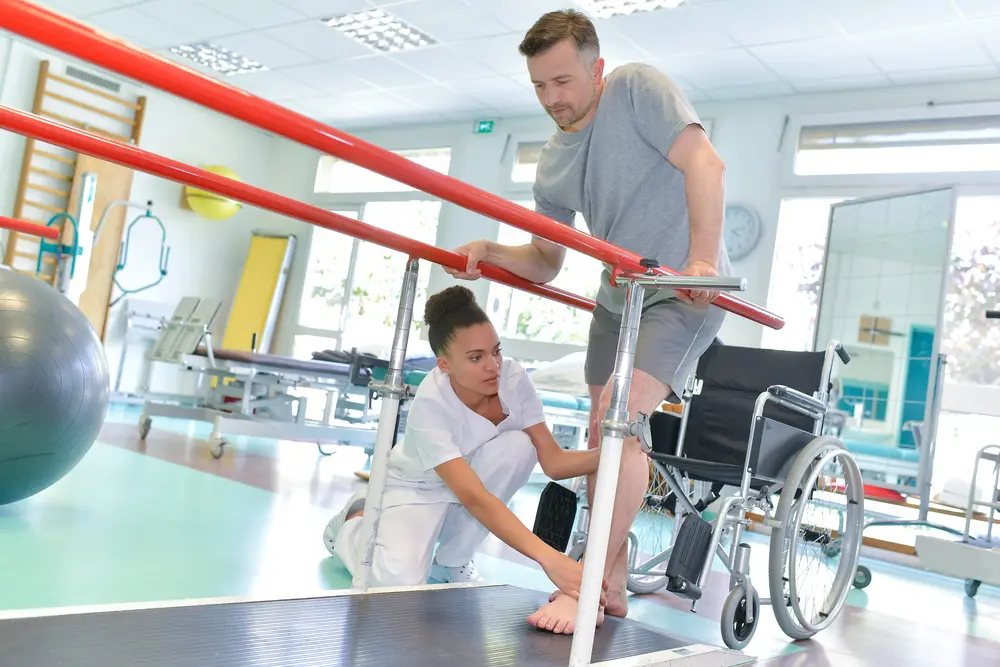Are you a fitness enthusiast or a dedicated athlete who has suddenly been sidelined by a nagging, persistent pain in your calf and ankle? That sharp or aching sensation that flares up during or after activity could be the result of Achilles tendonitis. The Achilles...
We’ve all seen soccer players sidelined by common but painful injuries like ankle sprains, knee ligament tears, and muscle strains. The combination of running, sudden stops, quick cuts, and potential physical contact makes the body, particularly the lower extremities,...
People who suffer from varicose veins, chronic venous insufficiency (CVI), and other related health conditions know that their symptoms involve more than just cosmetic concerns. They also frequently cause pain, swelling, and more serious health problems. For these...
How Long Does a Spinal Injury Take to Heal?

Spinal cord injuries are among the most serious and life-altering injuries a person can sustain. The spinal cord, a complex bundle of nerves, is the primary pathway for communication between the brain and the rest of the body. When it’s damaged, a patient could be left dealing with everything ranging from chronic pain to partial or complete paralysis. That’s why it’s important to seek immediate medical attention for any suspected spinal injury.
But how long can you expect the recovery process to be? The answer, as you might expect, is that it depends on a variety of factors. Thankfully, the team at Premier Orthopaedics is here to help you understand spinal injury recovery times and find the best path forward.
The Average Time for a Spinal Injury to Heal
When it comes to spinal injuries, there’s no single, straightforward answer to the question of how long it takes to heal. The recovery timeline can vary dramatically from person to person, depending on the specifics of their injury and their individual circumstances. However, we can provide a general overview of what patients might expect.
First Few Days & Weeks
In the initial days and weeks following a spinal cord injury, the focus is on stabilizing the patient’s condition and preventing further damage. This often involves surgery to decompress the spinal cord, remove any bone fragments or foreign objects, and stabilize the spine with rods, screws, or plates. During this acute phase, patients are typically hospitalized and closely monitored for any complications.
The Following Months
The first few months after the injury are often a period of significant change and improvement. This is when the most rapid recovery tends to occur, as the spinal cord begins to heal and the body starts to adapt. Patients may regain some sensation or motor function during this time, although the extent of their recovery will depend on the severity of their injury.
After the First Year
After the initial phase of rapid improvement, the recovery process tends to slow down. However, that doesn’t mean it stops. Many patients continue to see gradual improvements in their function and quality of life for months or even years after their injury. This is where rehabilitation plays a crucial role. Physical therapy, occupational therapy, and other forms of rehabilitation can help patients maximize their recovery potential and learn to live with any remaining limitations.
Healing Differs From Person to Person
It’s important to remember that every spinal cord injury is unique, and so is every recovery journey. Some patients may make a full recovery, while others may be left with permanent disabilities. The key is to stay positive, work hard in rehabilitation, and celebrate every small victory along the way.
Factors That Affect Spinal Injury Recovery
As we’ve mentioned, the recovery timeline for a spinal injury is influenced by a wide range of factors. Understanding these factors can help patients and their families set realistic expectations and make informed decisions about their care.
Severity of the Injury
The single most important factor in determining the recovery time for a spinal injury is the severity of the injury itself.
Spinal cord injuries are classified as either complete or incomplete. In a complete injury, there is a total loss of sensation and motor function below the level of the injury. In an incomplete injury, there is some remaining function. Patients with incomplete injuries generally have a better prognosis and a shorter recovery time than those with complete injuries.
Level of the Injury
The level of the injury — that is, where on the spinal cord the damage occurred — also plays a significant role in the healing timeline. For example, injuries to the cervical (neck) region are typically the most severe, as they can affect function in the arms, legs, and even the muscles that control breathing. Injuries to the thoracic (upper back) or lumbar (lower back) regions are generally less severe, although they can still result in significant disability.
Age and Overall Health
The patient’s age and overall health can also impact their recovery. Younger patients and those who were in good physical condition before their injury tend to recover more quickly and completely than older patients or those with pre-existing health problems. This is because younger, healthier bodies are better able to heal and regenerate.
Type of Treatment
The type of treatment a patient receives can also make a big difference in how long it takes to heal from a spinal injury. Surgery to decompress the spinal cord and stabilize the spine can help prevent further damage and improve the chances of a good outcome, while a comprehensive rehabilitation program can help patients regain as much function as possible.
Mental and Emotional State
Finally, it’s important not to underestimate the role of the patient’s mental and emotional state. A spinal cord injury can be a traumatic and life-changing event, and it’s normal for patients to experience a wide range of emotions, including shock, denial, anger, and depression. However, those who are able to maintain a positive outlook and stay motivated in their rehabilitation are more likely to achieve a better outcome.
How Premier Orthopaedics Can Help You Recover From a Spinal Injury
A spinal injury may be life-changing, but it doesn’t have to define your future. With the right spinal care and support from Premier Orthopaedics, you can regain function, reduce pain, and improve your quality of life. We’ll work with you to develop a personalized treatment plan that’s tailored to your specific needs and goals and provide you with the education and resources you need to understand your injury and take an active role in your recovery.
While the timeline for recovery may vary, the team at Premier Orthopaedics is here with you every step of the way. Schedule an appointment with an orthopedic specialist near you and start your journey to a speedy recovery today.
